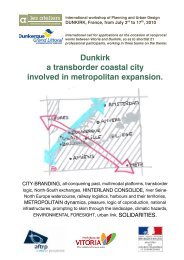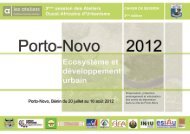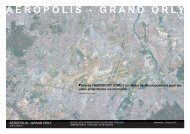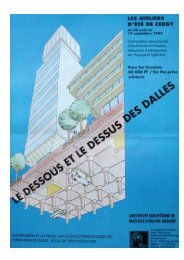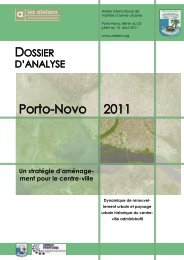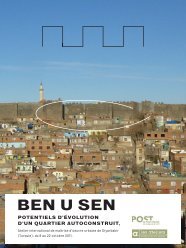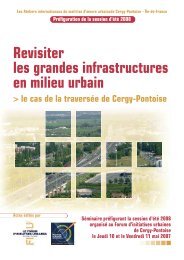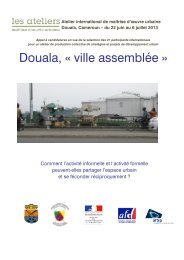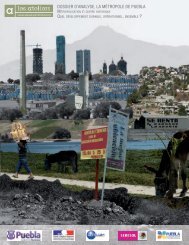les ateliers de maitrise d'œuvre urbaine en asie
les ateliers de maitrise d'œuvre urbaine en asie
les ateliers de maitrise d'œuvre urbaine en asie
You also want an ePaper? Increase the reach of your titles
YUMPU automatically turns print PDFs into web optimized ePapers that Google loves.
LES ATELIERS DE MAITRISE D’ŒUVRE URBAINE EN ASIE<br />
Literally "pockets of cities" are emphasized, thereby<br />
ignoring their neighbouring areas. The city has to escape<br />
from "functionalist" overwhelming scale in or<strong>de</strong>r to reach<br />
the "real" human scale, the scale of intermediary qualities.<br />
Individual initiatives may take over the responsibility of<br />
this new distribution of quality. Thereby, may come a new<br />
vitality in urban <strong>de</strong>velopm<strong>en</strong>t and a new form of "urban<br />
spirituality".<br />
THE DEATH OF THE IDEAL CITY :<br />
PERCEPTION AND "STRUCTURING"<br />
OF THE SCHIZOPHRENIC CITY:<br />
The recognizing of the <strong>en</strong>d of the i<strong>de</strong>al city is proof of our<br />
un<strong>de</strong>rstanding that the world is imperfect. After thousands<br />
of years of attempts through writings and local utopian<br />
realizations (i.e. F.L.Wright, and P. Solari), the human<br />
constructions on earth have little power to improve the<br />
society and little capacity to perpetuate as uniformly<br />
perfect. The constant mutation of needs leading to <strong>de</strong>cay<br />
(i.e. Antique abandoned cities) and the change in<br />
appreciation of things affects largely all theoretical<br />
princip<strong>les</strong> to bring them back to reality (i.e. The city of<br />
Detroit).<br />
Thereby seclu<strong>de</strong>d areas may be viewed as mom<strong>en</strong>tarily<br />
perfect. But these are merely refuge areas and as such have<br />
limited impact to modify larger systems or processes of city<br />
fabrications. By <strong>de</strong>finition seclu<strong>de</strong>d areas are closed and as<br />
such refer back to the notion of interiority which opposes<br />
in a dual vision an insi<strong>de</strong> and an outsi<strong>de</strong> (i.e. Inn<strong>en</strong> and<br />
Auss<strong>en</strong>, G.Dorf<strong>les</strong>). Similarly, society rejects what is<br />
exterior to itself un<strong>de</strong>r the name of madness. This explains<br />
complex relations of insi<strong>de</strong>/outsi<strong>de</strong> because it relates<br />
directly to society's innermost subjectivity (i.e.S. Felman).<br />
Oft<strong>en</strong> the outsi<strong>de</strong> is thought of as chaos due to the fact<br />
that the ru<strong>les</strong> are too "labyrinthic" to grasp for direct<br />
compreh<strong>en</strong>sion. However, chaos is where ru<strong>les</strong> are brok<strong>en</strong><br />
to the ext<strong>en</strong>t that no viability is any longer possible and<br />
such an extremity is seldom reached. Chaos is a <strong>de</strong>monic<br />
vision opposed to i<strong>de</strong>alistic qualities of an imagined<br />
paradise ( chaos brings "déchirem<strong>en</strong>ts et rejets" to an<br />
unbearable level). Further more if one grasps the city as<br />
chaos one should ask why he qualifies it in those terms and<br />
what refer<strong>en</strong>ces it calls for. This questioning is as<br />
important as un<strong>de</strong>rstanding what constitutes the<br />
<strong>en</strong>vironm<strong>en</strong>t un<strong>de</strong>r consi<strong>de</strong>ration through such allusive<br />
connotations.<br />
The so-called good city fragm<strong>en</strong>ts versus bad city<br />
fragm<strong>en</strong>ts are caricature readings of the city. They do not<br />
exist as unbridgeable disconnected <strong>en</strong>tities.<br />
WHO IS THE OBJECT, WHO IS THE SUBJECT?<br />
Psychoanalytic theories distinguish two types of people:<br />
those who support consequ<strong>en</strong>ces of pre-exist<strong>en</strong>t factors<br />
and those who act to modify and participate in the<br />
elaboration of these factors. But we may observe that most<br />
of the time both types, carrying the same collective<br />
unconscious roots, link directly the observer who later<br />
becomes the actor.<br />
For instance, a small child who litters in the city street has<br />
un<strong>de</strong>rstood that littering insi<strong>de</strong> the family premise is<br />
prohibited: thereby, he has structured the world to separate<br />
interior and exterior, the exterior needing not to be<br />
respected along similar ru<strong>les</strong> as the interior. Later the same<br />
person as an adult having built this subconscious<br />
separation will act along his own hierarchy of spaces<br />
consi<strong>de</strong>ring the exterior as evil, a world needing <strong>les</strong>s care<br />
because it is outsi<strong>de</strong>.<br />
CYNICISM AND THE CITY AS MERE TOOL:<br />
If we consi<strong>de</strong>r that planning embraces all transformed<br />
<strong>en</strong>vironm<strong>en</strong>ts connected directly or indirectly to the<br />
elaboration or the evolution of cities, th<strong>en</strong> roads, industrial<br />
factories, <strong>en</strong>ergy plants are part of the <strong>en</strong>vironm<strong>en</strong>t at<br />
stake. All this transformed <strong>en</strong>vironm<strong>en</strong>t has little reason to<br />
be other than an attempt to upgra<strong>de</strong> human am<strong>en</strong>ities for<br />
better living. May we consi<strong>de</strong>r that means for human life<br />
are not supposed to go against comfort on earth?<br />
From now on, means for curr<strong>en</strong>t human life should not<br />
risk to damage the future of life on earth. This nontemporal<br />
vision presupposes a high level of responsibility<br />
leading to clear choices for the actors at all levels. Thereby,<br />
no <strong>de</strong>cision should ever risk creating more damage than<br />
good. This point of view is wi<strong>de</strong>ly admitted for the respect<br />
of the quality of air and water, furthermore it is clearly<br />
expressed for the preservation of nature (i.e. A. Berque)<br />
but seldom treated for the built <strong>en</strong>vironm<strong>en</strong>t at large. In<br />
this manner, a city such as Ath<strong>en</strong>s seems to be in this<br />
condition and appears to be un<strong>de</strong>r this effect of cynicism.<br />
The city is unavoidably both beautiful and ugly as in a<br />
schizophr<strong>en</strong>ic nightmare.<br />
THE MYTH OF THE SAVAGE CITY:<br />
The savage world un<strong>de</strong>rstood as a contemporary<br />
achievem<strong>en</strong>t seems altogether to be a result of the<br />
schizophr<strong>en</strong>ic effects in city thinking, hiding serious risks<br />
for the future of cities. Appar<strong>en</strong>tly originating in fairy ta<strong>les</strong>,<br />
the contemporary savage world is a romantic fantasy which<br />
transforms itself into a world of discomfort and constant<br />
fighting for survival.<br />
This myth amplifies the separation betwe<strong>en</strong> the good and<br />
the bad. It makes a caricature of human beings as so called<br />
glorious warriors in a hostile <strong>en</strong>vironm<strong>en</strong>t. With the<br />
exception of pure masochism, one won<strong>de</strong>rs why human<br />
beings would want to build a world of discomfort? The key<br />
is to locate what is real savagery, the cultural c<strong>en</strong>ter looking<br />
like a "tamed" power-plant or the power plant as a noman's<br />
land expanding to uncontrollable ext<strong>en</strong>ts.<br />
LINKS AS OVERSIMPLIFIED SOLUTIONS:<br />
In or<strong>de</strong>r to upgra<strong>de</strong> <strong>de</strong>fective city areas, solutions of are<br />
proposed to create transportation connecting good and<br />
bad parts of the city. In schizophr<strong>en</strong>ia, the illness is not so<br />
much in the gaps but in the <strong>de</strong>ep split betwe<strong>en</strong> m<strong>en</strong>tal<br />
worlds with differ<strong>en</strong>t structures. The way to remedy to<br />
these problems is to put in place solutions which treat the<br />
parts within themselves.<br />
Rapport <strong>de</strong> la 4 ème session <strong>en</strong> Asie - SHANGHAI / Chine 2000 38 11/03/2009




